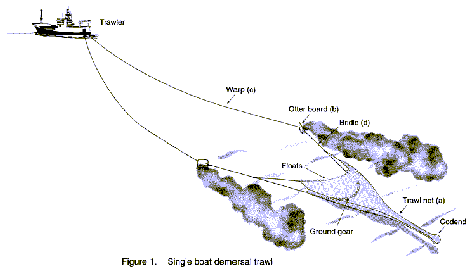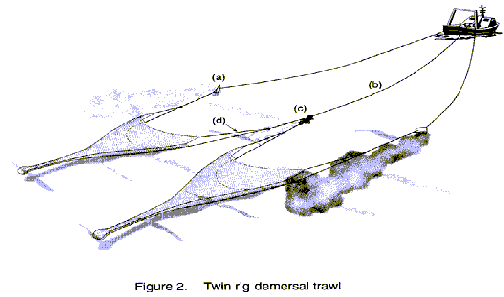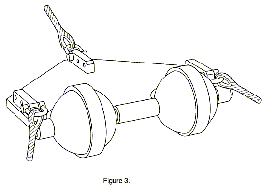|
Profile of the UK Fishing Fleet
2. In 1998 UK vessels landed just over 924,000 tonnes of fish and shellfish into the UK and abroad with a first hand sale value of £662 million. The number of active vessels of 10 metres and over totalled 2,150, with approximately a further 5,000 inshore vessels under 10 metres in length fishing mainly with static gear. A detailed breakdown of the composition of the over 10 metre fleet is given in Table 1. In addition to the number of vessels, the minimum, mean, median and maximum values for overall length, gross tonnage and main engine power are included for each category. It should be noted that these figures apply only to fishing vessels registered in the UK; foreign vessels using different gears also operate within British Fishery Limits. A description of the methods of capture with the relevant information on gear components is set out below, together with a summary for common fishing gears.
(i) DEMERSAL OR BOTTOM FISHING METHODS
Demersal Trawl (Otter Trawl)
2.1
This is by far the most commonly used towed gear in UK fisheries. Both finfish and shellfish species found on or near the bottom are taken by this method. A diagram of the gear deployed in fishing mode is set out in Figure 1. The trawl net (a) is cone or funnel shaped with wings extending forward to guide fish back into the funnel and ultimately the cod-end, the rearmost and narrowest part of the trawl where the catch is collected. Otterboards or trawl doors (b) are heavy metal devices designed to keep the gear on the bottom and provide hydrodynamic spreading forces to open the gear horizontally. Details of some types in current use can be found in Appendix A/Otterboard performance and Behaviour, Commission of the European Communities. The otterboards are connected to the towing vessel by steel wire ropes known as trawl warps (c), and to the net with wire or combination ropes called bridles (d) or sweeps. The weighted groundrope, constructed of wire or chain strung through rubber discs, rockhopper or metal bobbins, serves two purposes. It protects the lower mouth of the trawl net from sea bed damage and is weighted sufficiently to ensure good bottom contact is maintained. Floats are attached along the headline or upper part of the net mouth to open the trawl vertically. The entire assemblage is towed by the trawler at a speed of 3 knots (min 2, max 4). Warp length/water depth ratios range from 4:1 or more in shallow water (25m) to 2:1 in deep water (1000m) with 3:1 the norm on the majority of fishing grounds on the continental shelf (50m -200m). Bridle/sweep lengths between otterboards and net also vary considerably, from a few metres to 180 metres depending on target species and nature of sea bottom. On smaller vessels, combination (polypropylene/steel) wire may be used as sweeps and on larger vessels mid-link chain may form part of the rig.
Typical (and maximum) values for above components:- Trawl warp (c) wire diameter 20mm (28mm); Bridle/sweep (d) wire diameter 20mm (32mm or 19mm chain); Otterboard (b) size and weight 5.3 square metres x 1400 kg (8 square metres x 3000 kg).
Twin Rig Demersal Trawl
2.2
The essential elements of twin rig trawl gear are set out in Figure 2. This gear is generally used for target species tight on the bottom, such as angler, flatfish and Nephrops. By towing two nets side by side the effective swept area, and hence catch, is increased. As with the single demersal trawl above otterboards (a) provide the horizontal spreading forces and floats and groundropes the vertical forces. The obvious difference in rigging is the third wire or central warp (b), which runs from the vessel to the clump (c), a heavy weight which can consist of short lengths of chain cable shackled together or a custom made device (Figure 3) designed to roll rather than be dragged along the bottom. Warp length/water depth ratios are similar to those used with the single demersal trawl and bridles/sweeps (d) can be steel wire, combination wire, chain or a mixture of all three. Normal towing speed used is 2.5 knots (max 3.5 knots).
Typical (and maximum) values for above components:- All three trawl warps wire diameter 20mm (24mm); Bridle/sweep (d) wire diameter 16mm (26mm combination, 19mm chain); Otterboard size and weight 2.84 square metres x 600 kg (5.4 square metres x 1500 kg); Clump weight 620 kg (2000 kg).
|


